Tottenham Hotspur returned to Premier League action against Watford on a cold evening at Wembley. Mauricio Pochettino’s side were looking to cement their place in the running for a Champions League place and put a tough week behind them after back to back FA Cup & League Cup exits. Watford, having a strong season under Javier Gracia, arrived in ninth position in the table, knowing a victory would see them leapfrog Everton and Wolves into seventh.
With Tottenham looking to win their first trophy in over a decade a victory was needed to keep them on the fringe of a title race. In the end, Spurs ran out 2-1 winners with a victory that had to come the hard way after a late turnaround. Tactically the game had some moments of interest in the first half as Spurs dominated the ball with Watford offering a threat on the break. Watford, leading 1-0 at half time, were content to frustrate in the second half, with Spurs eventually finding two late goals to take the points.
Lineups

Mauricio Pochettino once again had his work cut out in selecting his starting line-up. With star players Harry Kane and Dele Alli missing through injury, the Argentine would have to conjure up some more magic to give Spurs an attacking threat. Spurs were boosted by the return of Son Heung-min from international duty, but there were concerns about the South Korean’s freshness going into the game. Indeed, with the sheer amount of injuries Spurs have accrued throughout the season, there are a lot of Spurs players running on empty at the moment.
Spurs lined up in a 3-5-2 system, with their first choice back three of Davinson Sanchez, Jan Vertonghen and Toby Alderweireld tasked with keeping a lively strike pairing of Troy Deeney and former Barcelona man Gerard Deulofeu quiet. Up front Fernando Llorente was again selected, with Son playing off the Spanish target man. Spurs’ central midfield has been an issue this season, but Pochettino has found a formula that works with Winks and Sissoko, who were joined in a three by Christian Eriksen.
Watford lined up in a 4-2-2-2 system, but their shape in truth took on many guises dependent on the phase of play and game situation. Up front Deeney and Deulofeu are a handful for most defences, offering both hold-up play and a threat in behind, whilst the positioning and movements of Pereyra and Hughes provided some tactical interest during the first half.
Opening exchanges
The game soon took up a familiar pattern, as Spurs dominating the ball with Watford content to soak up pressure and look to hit their hosts on the counter-attack. This was of course to be expected. The key tactical themes to look out for included how Spurs would use the ball, their positioning and movement to break down Watford, and how the Hornets were set up to counter-attack and provide a threat of their own.
Watford’s defensive strategy was to press Spurs’ initial build-up, but if this was bypassed to drop into a deep and narrow block. This is a common tactic against Spurs, where they have had issues this season in playing out from the back. Hugo Lloris is not the finest ball-playing goalkeeper. With the injury and then January departure of Mousa Dembele, they have struggled to cleanly play the ball out through pressure as they have under Pochettino in the past.
Despite these issues Spurs still looked to play out from the back. Players were positioned on multiple layers of the pitch, as we have come to expect from Mauricio Pochettino’s positional play system. In this system, they will either look to find Harry Winks as the free player to turn and play forward, or to create space for Vertonghen or Alderweireld to step into midfield with the ball.
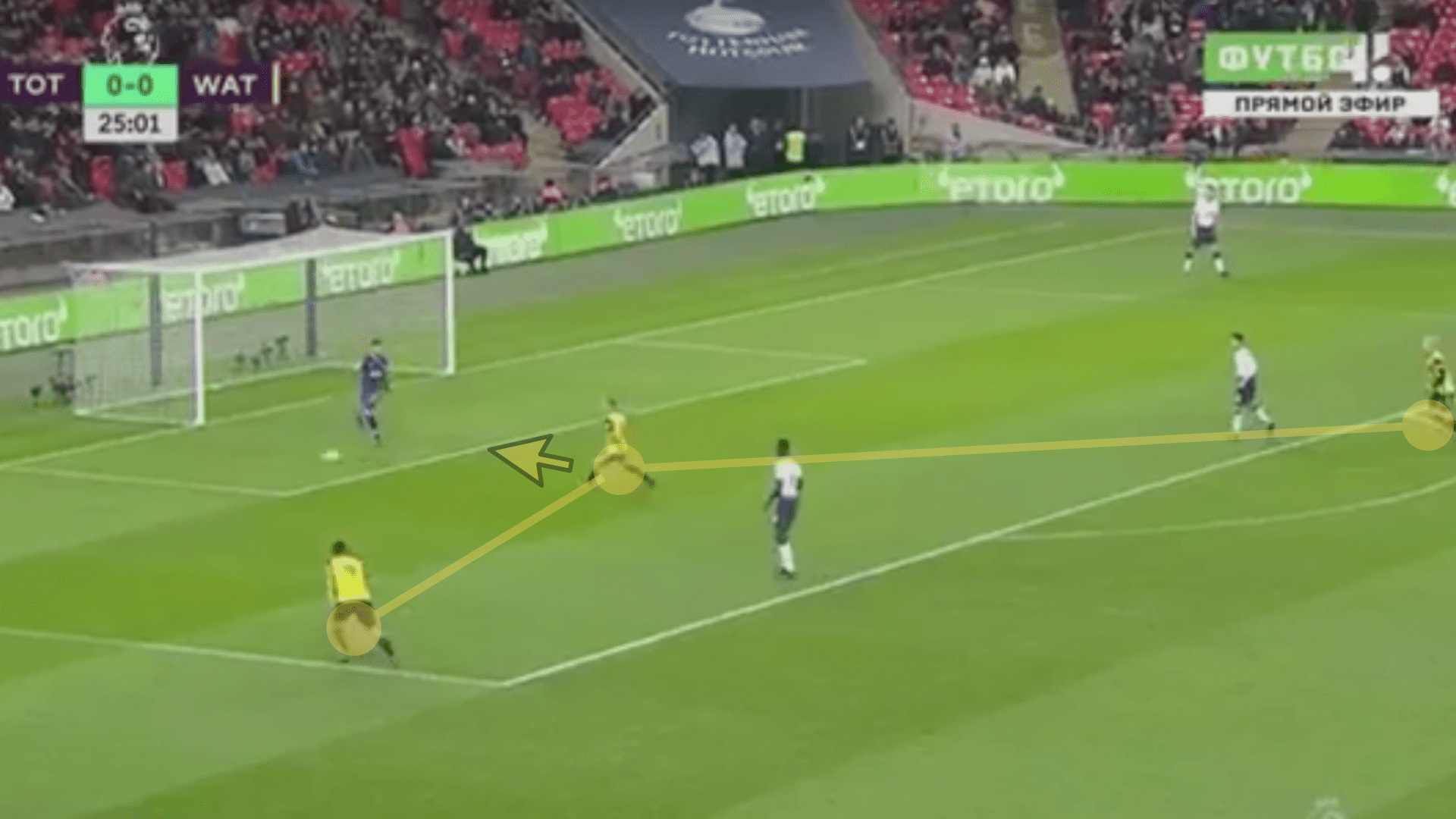
Here Watford have committed three players to press Spurs. Notice how Deulofeu closes down Lloris – who is liable to playing bad, underhit passes under pressure – whilst also keeping Sanchez in his cover shadow. The aim for Watford here is to block any central progression as Hughes keeps tight to Winks (the player Spurs would like to get on the ball), and allow the pass out to one of the split centre-backs. Once this pass is played the three pressing players will shift towards the ball whilst blocking passes inside.
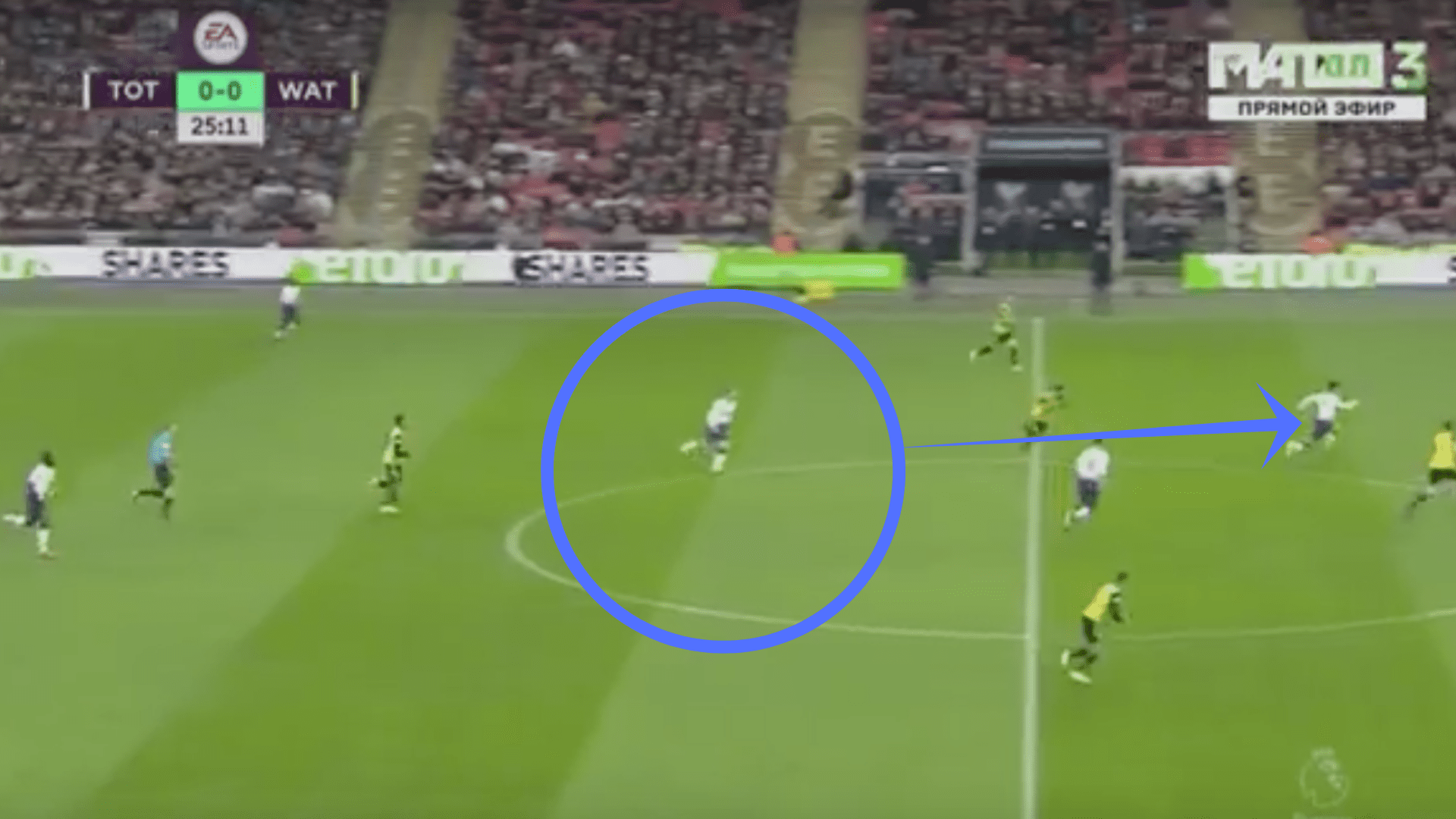
In this instance however, Spurs still retain a 5v3 numerical superiority. Alderweireld bounces the ball back to Lloris, now a free player, who is able to play a longer pass into Eriksen in acres of space behind the line of Watford pressure. Unfortunately for Spurs it is slightly overhit, and Eriksen’s flicked header doesn’t quite put Son through on goal.
With Spurs’ back three in place, this allowed both Danny Rose and Serge Aurier to move into high positions early on in the build-up. As Spurs progressed their lines up the field and got their defenders to the halfway line, both Rose and Aurier would play high and wide on the last line of Watford’s defence.
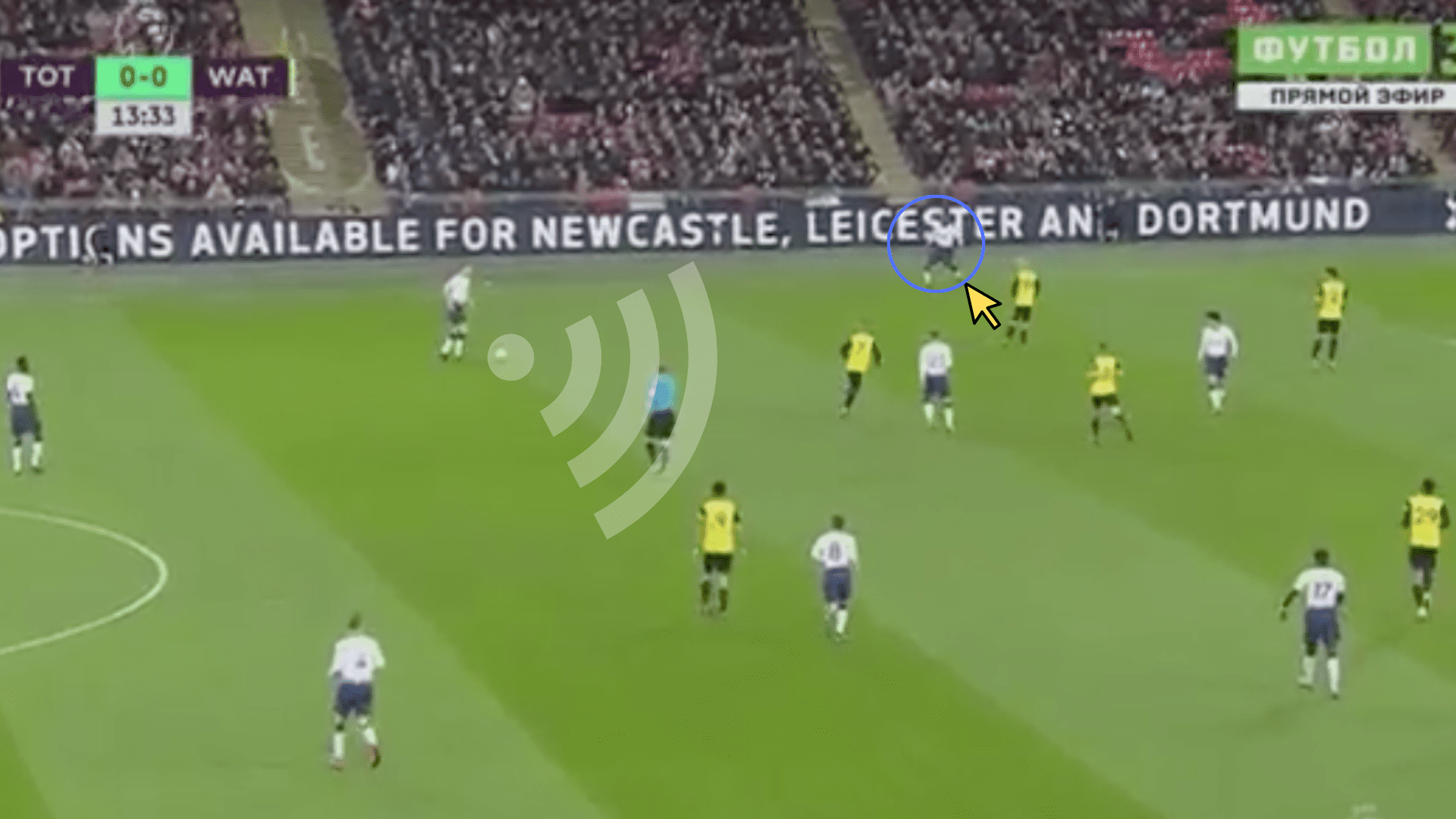
Notice here how Will Hughes is charged with covering Danny Rose. This could have been due to Gracia expecting Spurs to line up with a back four, where Hughes would track Rose, and right-back Janmaat pick-up a left winger. As it happened, Janmaat was able to stay narrow and compact, while Hughes was dragged into the back line due to Rose’s high positioning. This allowed Vertonghen plenty of time and space to move high with the ball into Watford’s half.
Spurs however are not one dimensional. With their issues in progressing the ball cleanly out of the back and through midfield, Pochettino has had to find other solutions for his team. This has resulted in his team playing more directly into the central striker, or playing long balls for runners down the channels or over the top. Here they were also not afraid to play direct into Llorente with Eriksen and Son in close support.
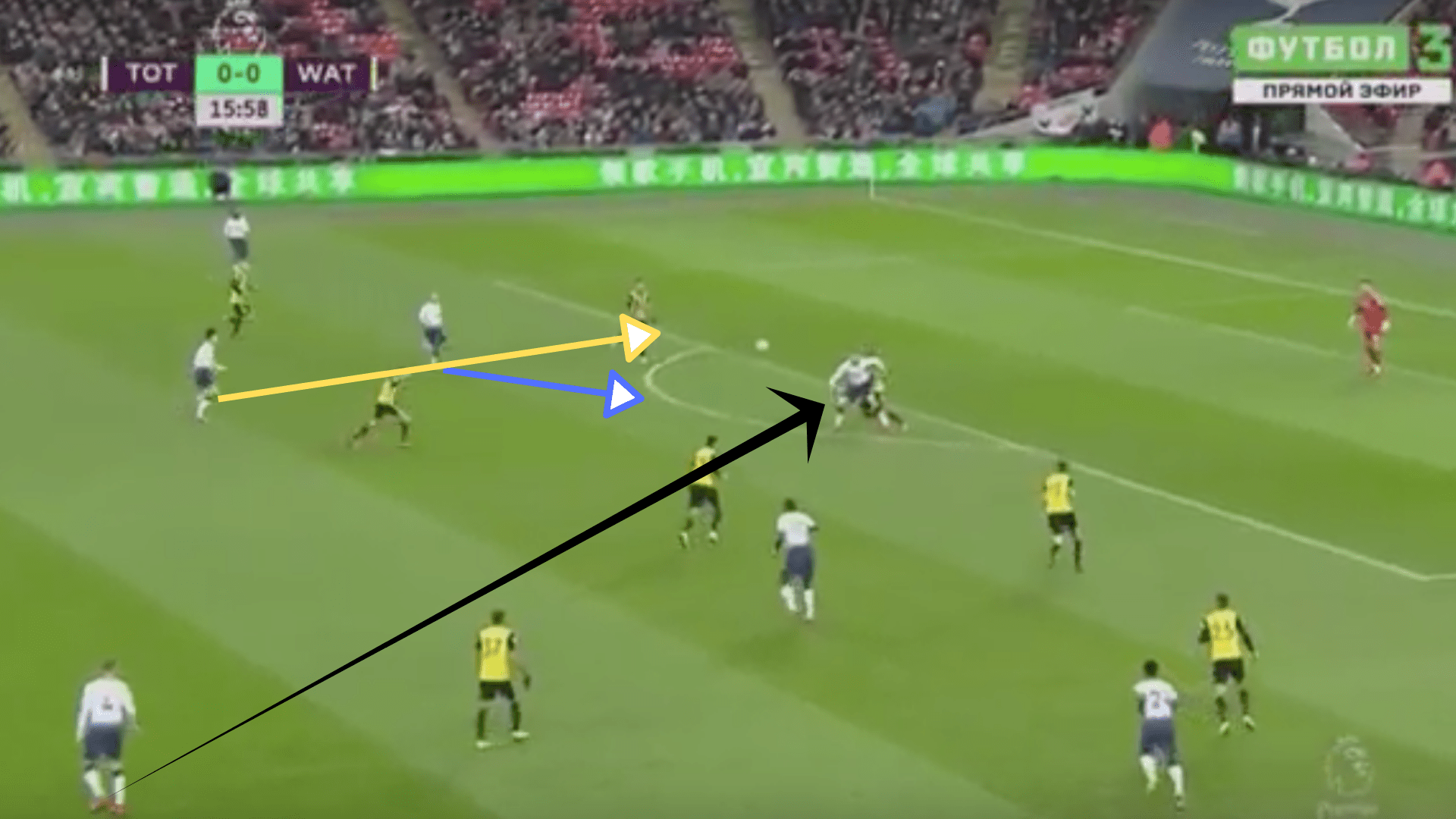
On this occasion it is Alderweireld who has stepped into midfield with the ball, playing a chipped pass into Llorente. As soon as Alderweireld lifts his head before passing, Eriksen has already read the situation and makes a late supporting third-man movement towards Llorente. As Eriksen supports, Son recognises his opportunity and makes a forward run himself. Llorente’s touch to Eriksen is perfect. The Dane plays a delightful reverse pass to Son who bursts into the box, but his first touch is too heavy to get a shot away.
Spurs issues in possession
Missing both Harry Kane and Dele is obviously going to have an effect on the attacking output of Spurs. Here Son and Eriksen were tasked with keeping the attack functioning, but they ran into several issues which impeded their usual fluent forward play.

In this situation Aurier and Sissoko are in a 2v3 underload, but there is space to be exploited behind Holebas, Watford’s left-back. Son however has a dilemma: if he makes the run into the space, Llorente will now be isolated.
Usually you would see Son make this type of run. With Eriksen deeper though (out of picture) there is limited support high up the pitch. In this situation Sissoko and Aurier do not have the quality to play out of the underloaded zone.

This example demonstrates the difficulty Eriksen had all game. He was both Spurs’ best option to pass from deeper positions, but also the best option to receive between the lines in the absence of Dele. In this scenario he recognises there is space between Watford’s lines and moves into it to support Son and Llorente.
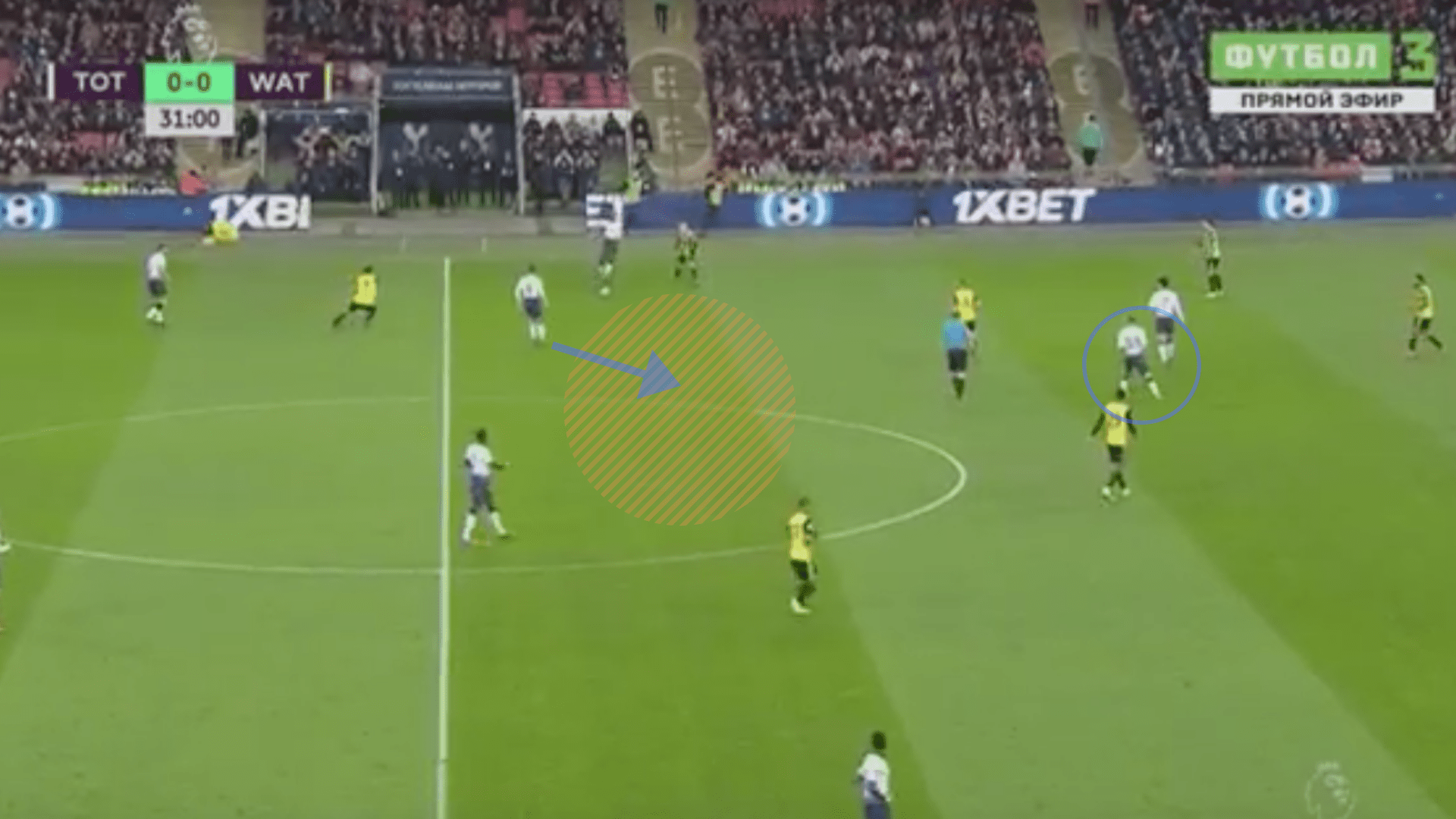
As Eriksen moves to position himself between the lines, Rose plays the ball inside to Winks. Instead of opening his body and taking his first touch forward, he receives with a closed body position and protects the ball from Deeney who is pressing him. Had Winks not moved so close to the ball to receive, but instead moved away from Rose and opened his body shape up, he could have received with space and time to play forward into Eriksen. You sense had it been the Dane receiving that pass himself the outcome would have been more favourable to Spurs.
Watford counter-attacking threat
In the first half Watford were able to provide a real counter-attacking threat to Spurs. They used an initial long ball into Deeney, who is excellent at pinning defenders and holding up the ball. Watford would look to break quickly with runners supporting and running off the target man.
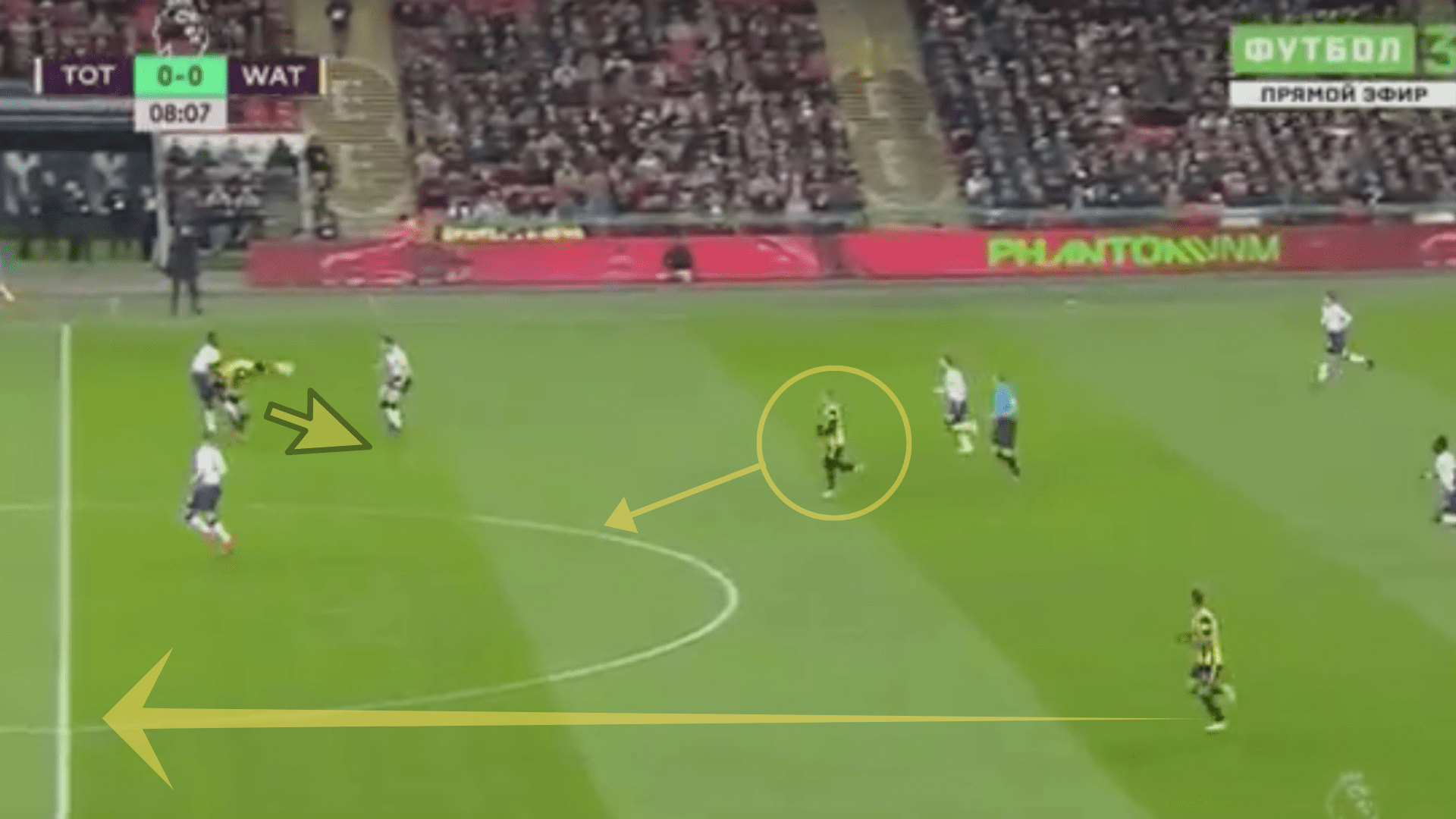
Here a long ball is nodded down by Deeney to Deulofeu, who takes up an excellent supporting position to receive and play forward. This triggers a third-man run from Pereyra who runs into the space left in behind Aurier who is still upfield. The pass from Deulofeu however is slightly delayed, and allows Spurs to just recover in time. It is still an excellent example of a coordinated and direct up back and through combination.
Watford’s positioning whilst in possession
On the rare occasions Watford had an established shape in possession, or from goal-kicks, their shape morphed into more of a 4-3-3 arrangement, with Deeney and Deulofeu being joined in occupying Spurs defensive line by Roberto Pereyra. This ploy was designed to give as many players threatening Tottenham’s defensive line as possible, and to pin them back into a defensive line of five. With supporting runs inside from Hughes and Capoue this gave them a reasonable opportunity to win second balls without compromising on defensive security with five men left behind the ball.
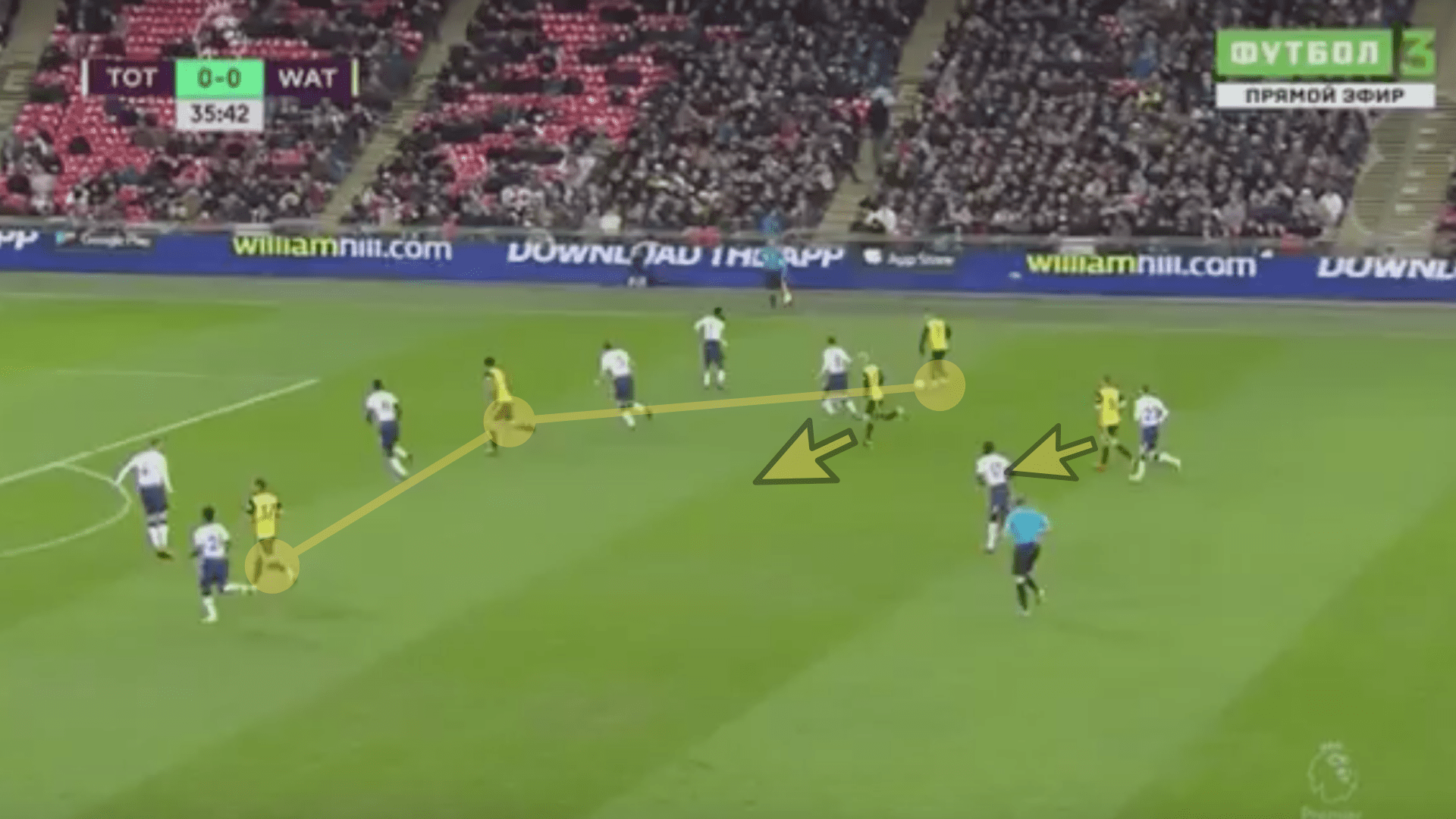
This brought about some pressure on the Spurs goal late in the first half, and in doing so forced a corner from which Cathcart gave the Hornets the lead. Hugo Lloris, subject of much recent criticism, came to claim the cross unsuccessfully. His failure gifted a soft goal to Watford and left further question marks over the Spurs captain and World Cup winner.
Second half
They say goals change games, and this was absolutely no different. Watford came out in the second half intent on preserving their lead rather than looking to extend it. The ambition on the counter-attack and positioning of three players on Spurs back-line stopped, with the game looking like an attack vs defence training exercise.
Spurs made one change at the break, with Lucas Moura replacing Serge Aurier who had not had a successful first half. This meant Moussa Sissoko moved to right wing-back, with Moura joining the midfield three alongside Winks and Eriksen. Pochettino perhaps had noted the difficulty Eriksen was having in accepting all of the creative burden, and in Moura had someone able to accept the ball off Eriksen in between the lines, and to use his dribbling ability to cause problems for Watford.
Watford sat deep in a very compact 4-4-2 block, and were content to allow Tottenham the wings. This led to Spurs shelling in 25 crosses during the second half. For a team that does not usually cross the ball a great deal, this demonstrated the issues they had in creating chances without the talents of Dele and Harry Kane.
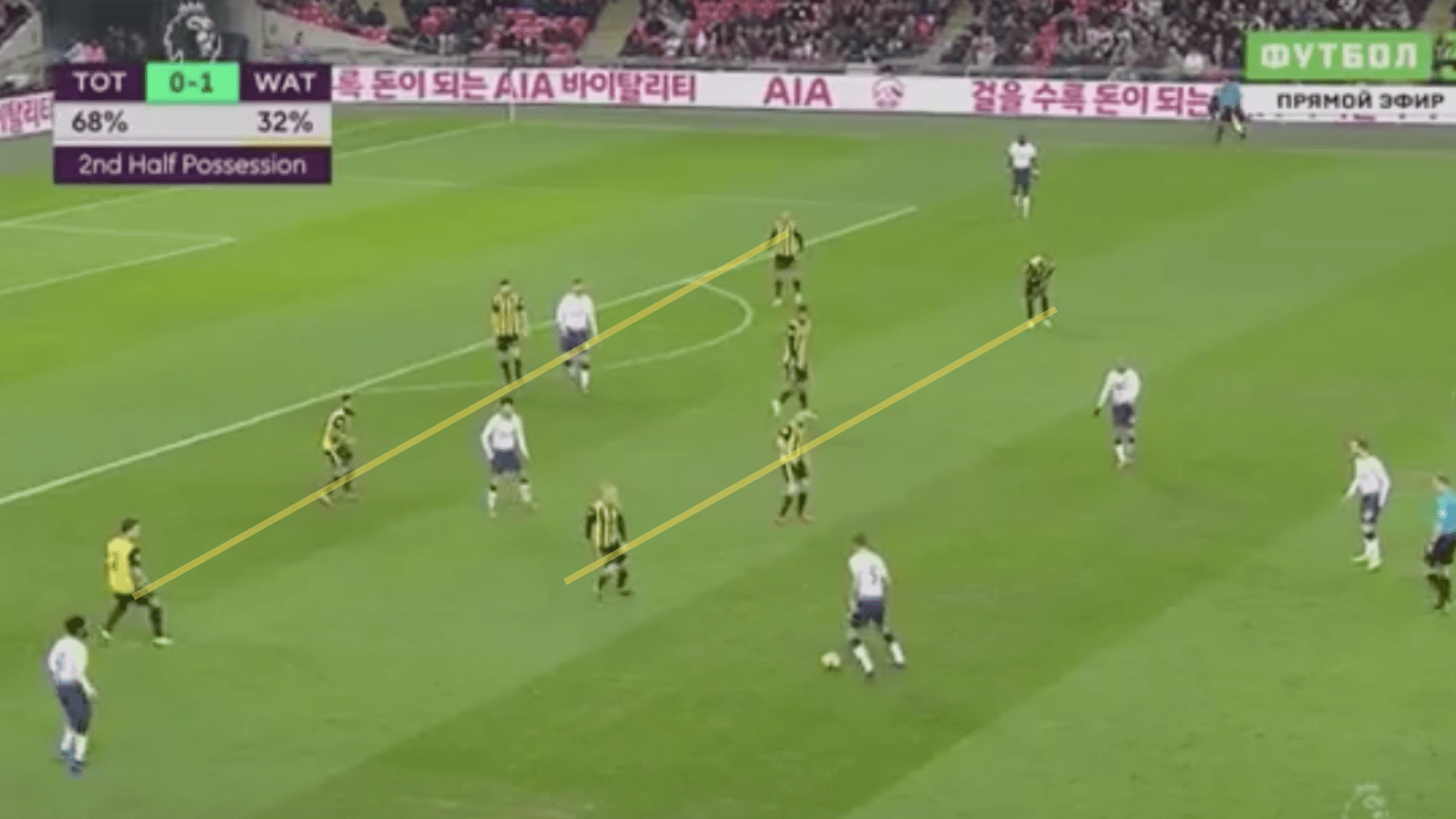
Watford’s block is extremely narrow, with the central midfield pairing staggered nicely to prevent simple combinations to bypass them. Notice how Hughes is no longer responsible for tracking the movement of Rose and sits in narrowly on the midfield line.
Here Vertonghen has carried the ball high up the pitch again. He spent much of the half as an extra midfielder, leaving Davinson Sanchez and Alderweireld to cover Deeney and mop up long clearances.
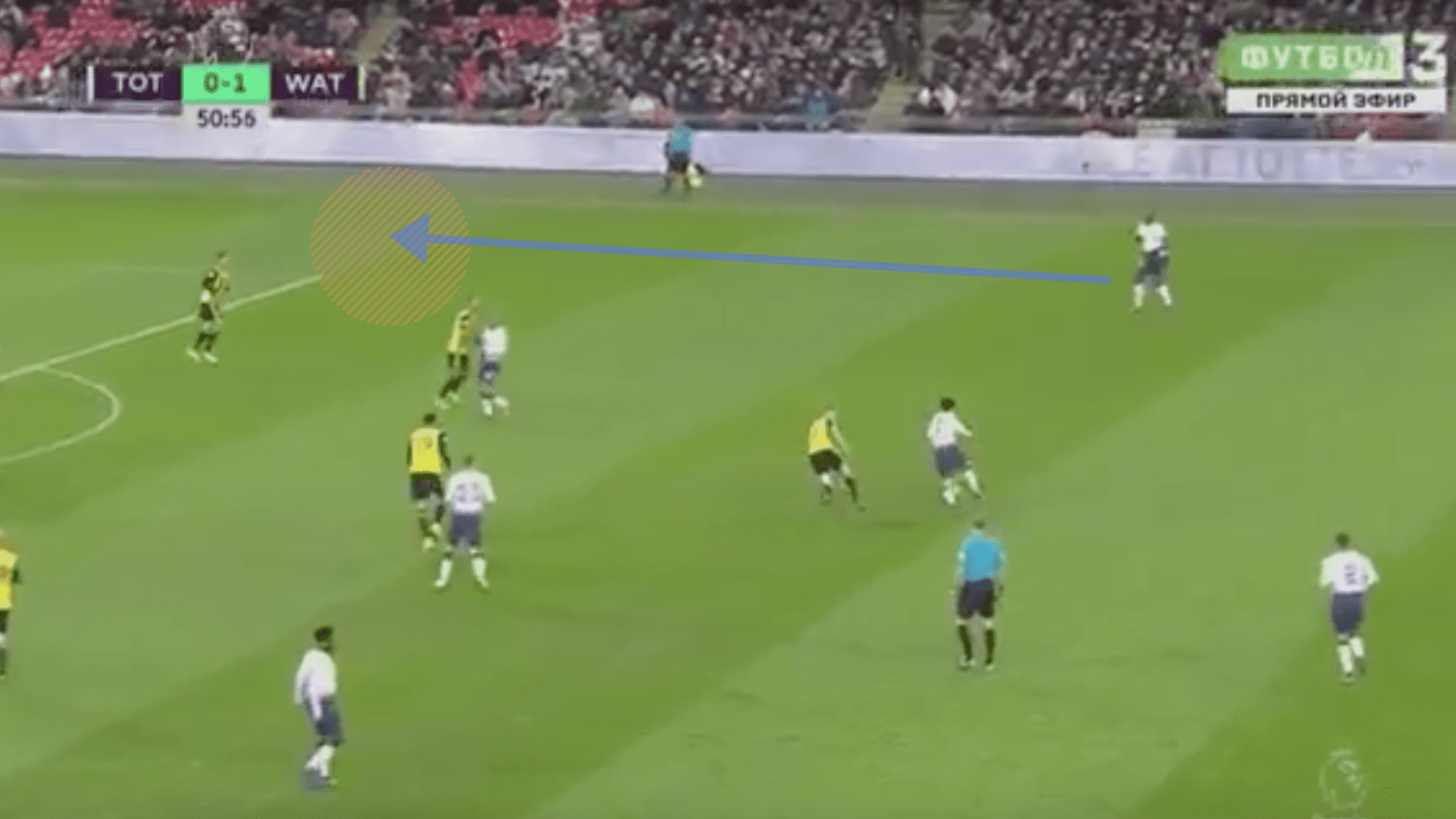
Here the Watford defence remains compact and narrow with little space to play through for Spurs. Instead, they utilise the space on the outside where Sissoko puts in a rare good ball for Llorente who has his first effort saved before comically volleying the ball over the bar from a matter of yards.
This approach from Watford was interesting because in Llorente Spurs had a significant aerial threat. Sitting deep and allowing crosses into the box may be seen as a risky strategy. With Spurs delivery from wide areas being so poor, Gracia would no doubt argue that this was a risk worth taking in trying to limit the spaces in which Eriksen, Son and now Lucas Moura could play in centrally.
As the game progressed it became even more one-way traffic. Spurs put in cross after cross into the box to no avail, with Pochettino introducing Kieran Trippier for Moussa Sissoko in the hope he could improve the delivery into the penalty area.
This was essentially admission from the Spurs manager that this undergunned Spurs attack was incapable of beating the Watford block, so they’d have to rely on continuing to fire balls into the box. It may not be the Spurs we’ve become accustomed to, but Pochettino is once again showing his willingness to be adaptable with his tactics.
Spurs comeback
The way the game was going, it was therefore a surprise that the Spurs equaliser came through a rare moment of disorganisation from Watford. By this time Pochettino had thrown on Erik Lamela for Jan Vertonghen and switched to a back four, which smacked more of desperation than a considered tactical move.
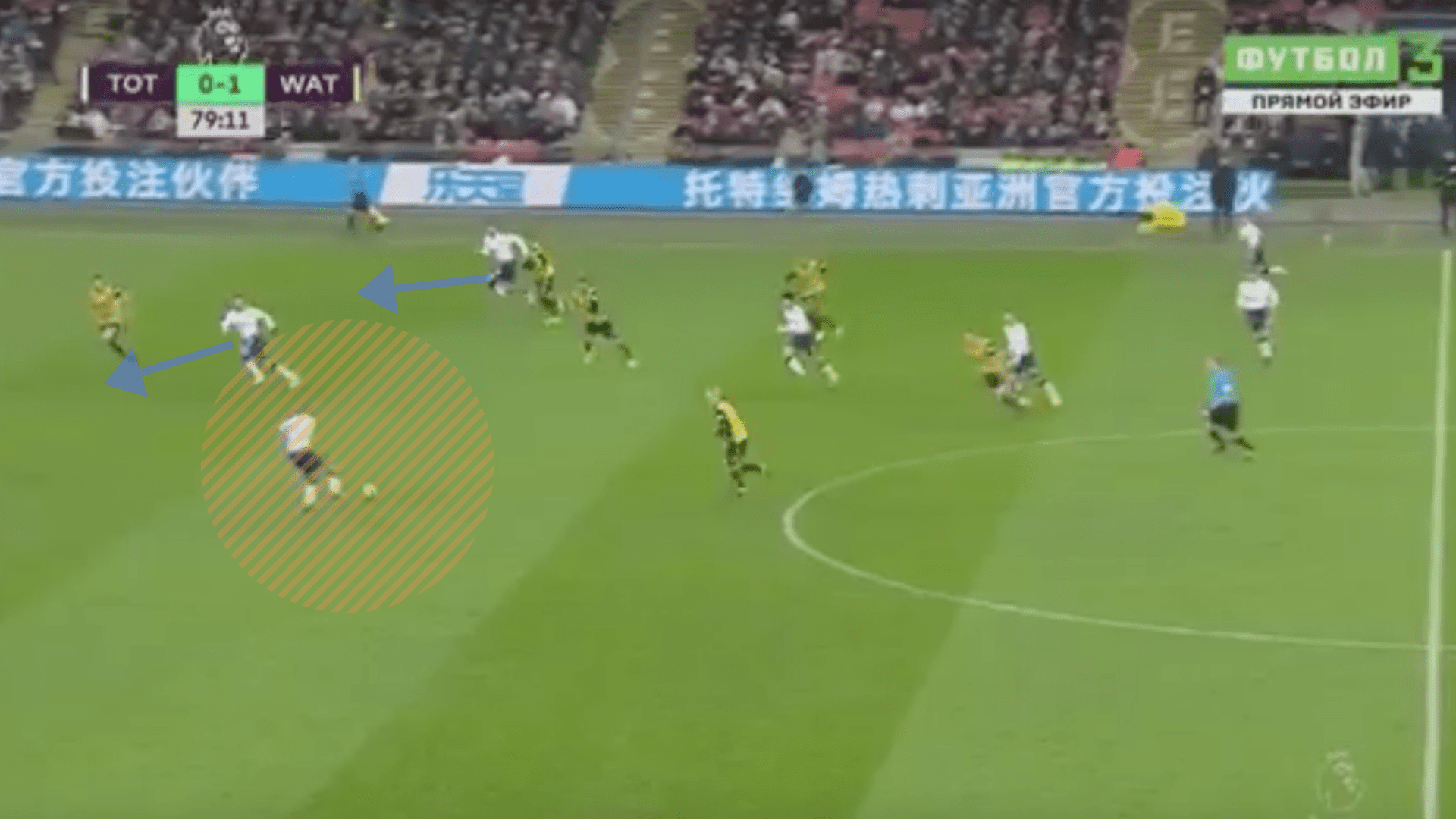
It worked though, as Eriksen found Moura with time to turn in some rare space between the lines. Lamela and Llorente both made runs in behind which caused confusion in the Watford defence. While Llorente took a bad touch from Moura’s through ball, the rebound fell kindly to Son who finished well.
It didn’t take long for Spurs to find a winner, as finally one of their many crosses into the box found Llorente’s head. Rose stood up a cross to the back post where Llorente guided the ball expertly past Foster in goal. It was vindication for Pochettino as fans had called for Llorente to be substituted all second half. With Spurs resorting to playing so many crosses into the box though, it was a more than wise move to keep him on the pitch.
Conclusion
This was probably just about a deserved victory for Spurs, even if they did make hard work of beating a Watford side that may slightly regret a lack of attacking ambition in the second half.
Tactically the game was far more interesting in the first half when the score remained 0-0. Then, Spurs dominated the ball but faced issues with a makeshift forward line and lack of creative players between the lines. Watford looked bright on the counter-attack with Deeney the focal point, ably supported by Deulofeu and Pereyra causing some concern for the home side.
They may rue their defensive game in the second half, as Spurs finally managed to find a way through. It would have been interesting to see if Gracia had maintained the first half strategy and counter-attacked more against a Spurs side committing more and more numbers forward.
It may not have been pretty for Spurs, but Pochettino has had a knack of coming up with solutions this season. He has dragged a team beset by injuries and fatigue to third in the league, and now they lie only two points behind Manchester City. The result was also testament to the endless belief this Spurs squad has in themselves. They just never seem to know when they’re beaten, as for the third time this Premier League season they claimed a winning goal after 85 minutes.
If you love tactical analysis, then you’ll love the digital magazines from totalfootballanalysis.com – a guaranteed 100+ pages of pure tactical analysis covering topics from the Premier League, Serie A, La Liga, Bundesliga and many, many more. Buy your copy of the January issue for just ₤4.99 here, or even better sign up for a ₤50 annual membership (12 monthly issues plus the annual review) right here.

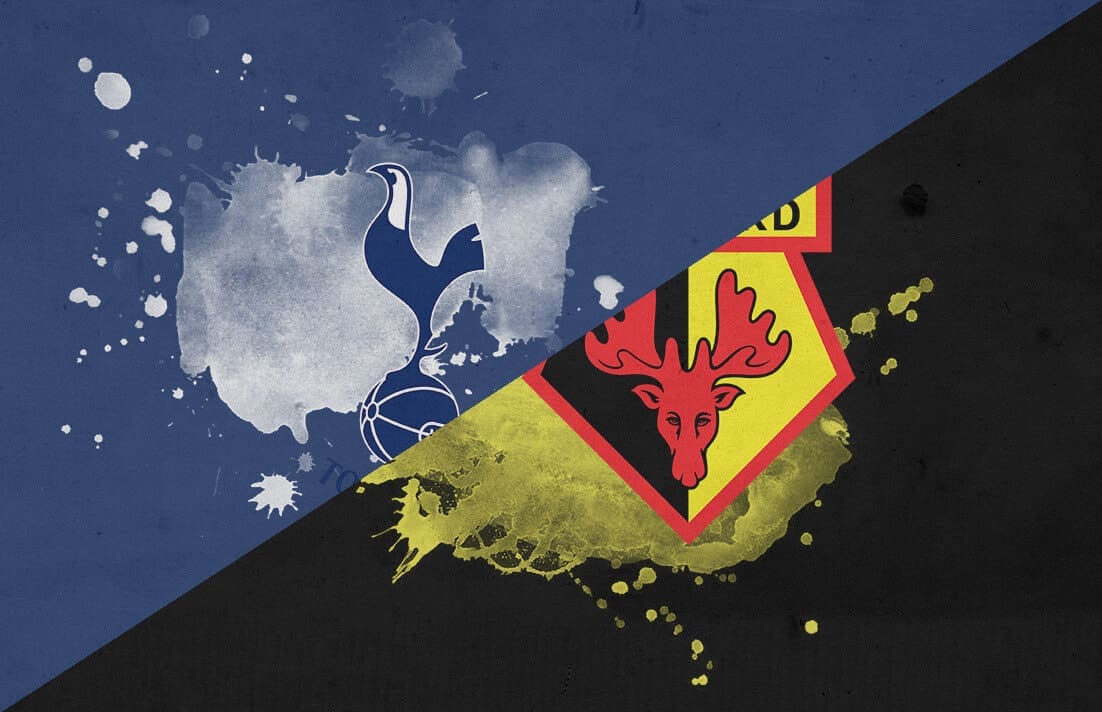



Comments